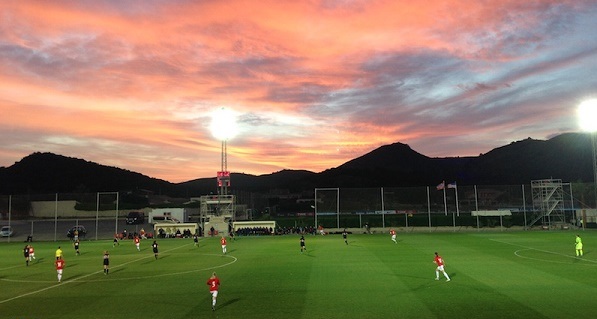Dougherty: How youth coaches, players and parents can help fix U.S. player development

 The shouting has quieted, and the debate featured on the front pages of many sports sections has moved to page 8 (or deeper). The U.S. Men’s National Team’s loss to Trinidad & Tobago was worthy of the attention it received, not only because of the U.S. failed to qualify for the World Cup Finals, but because the U.S. lost to Trinidad & Tobago, population 1.36 million.
The shouting has quieted, and the debate featured on the front pages of many sports sections has moved to page 8 (or deeper). The U.S. Men’s National Team’s loss to Trinidad & Tobago was worthy of the attention it received, not only because of the U.S. failed to qualify for the World Cup Finals, but because the U.S. lost to Trinidad & Tobago, population 1.36 million.
U.S. Soccer Federation will likely have a new president when elections are held February 10, 2018. Several people are running against current President Sunil Gulati, including former National Team players Eric Wynalda and Paul Caligiuri. That’s a good thing, as change is sorely needed.
Gulati and the U.S. Men’s National Team coaching staff – by design, I am not including the women’s program here – need to be held accountable. But to those of us who don’t have the clout to influence the big-picture stuff, there doesn’t seem to be a whole lot we can do beyond our sideline griping during our kids’ games on the weekend.
Or is there?
Actually, there is. And while this column is primarily directed to youth coaches, parents and players may find the following suggestions of use as well:
Center backs who can pass
Nothing drove me crazier during qualifying than watching center midfielder Michael Bradley drop back to within a few yards of his center defenders to collect the ball in his own half of the field in order to start an attack. It kept reminding me of basketball, where the point guard takes the ball from the big power forward to bring the ball up court. The reason: the power forward isn’t a dribbler; that’s not his role.
That should not, and must not, apply in soccer. In fact, I would make the case that the best passers on the field should be the attacking midfielder and the center backs. But it is clear to me that U.S. staff coaches do not have the confidence in their center backs to encourage them to make a pass of any significant distance. Only Michael Bradley is permitted that task.
Youth coaches: Teach your center backs to pass! Winning the ball from the opposition is only half their job; their other half is to initiate an attack with a good pass to the right teammate ahead of them. It might be the holding midfielder 10 yards away, or it might be the target player 50 yards away.
Center backs: Remember that just winning the ball isn’t enough. Your pass initiates the counterattack. Get your head up, get your body shape right, and connect that dot. Don’t leave it up to the holding midfielder to do your job.
Proper defending techniques
There’s a phrase that has stuck in my head since my college playing days, when coach Graham Ramsay taught us to “see man, see ball.” It’s a simple concept, but one that many players – including senior national team players – sometimes forget. If you can’t see the man you’re covering and the ball at the same time, you need to change the way you’re facing until you can see both. If a defender only watches the ball, the opponent he’s covering will slip behind him to collect a split pass and head to goal. If the defender only watches the player he’s marking, he has no idea when the ball is passed or crossed.
It’s a simple matter of adjusting the defender’s hips and shoulders, but too many youth coaches don’t emphasize this positioning.
Coaches: You’ll have a million opportunities every practice to make this coaching point. Emphasize good body shape every training session, and your players will know that it’s important. “See man, see ball” is all you’ll need to say.
Players: Don’t be a spectator on the pitch when the opponent has the ball. Don’t get beat on a split pass, don’t get megged, and don’t let that wide player slip behind you because you’re ball watching. Take it personally when you get beat. If every one of your teammates has that attitude, you’ll be a hard team to beat.
Shooting from distance
Good teams make life difficult for an opposing goalkeeper when they can shoot on frame, with pace, from distance. And by distance, I mean beyond 20 yards. But rarely do we see American players rip shots on frame, a fact that clearly is recognized by America’s CONCACAF opponents who know to pack in the defense without fear of a dangerous shot from distance. This guy knew how to shoot.
Michael Bradley’s goal against Mexico was brilliant for so many reasons, but what stood out to me is that it was so unusual for an American player to take such a chance. And there are other good examples of U.S. players scoring goals from distance. But they are few and far between, and many of the efforts we see today are woefully inaccurate.
Coaches: Encourage your players to shoot from distance when the situation is right, and emphasize the need to land on the kicking foot. And when the players get it wrong, fix it then and there. Reward “frozen ropes” – those shots that are hit so hard and low that they never dip until they hit the net.
Players: Sending a shot over the crossbar is not a time to laugh; it’s a time to take stock of your poor shooting ability and fix it right away. Defenders don’t laugh off getting beat one on one; you shouldn’t laugh when you miss a goal-scoring chance. Take pride in your shooting, and try and rip the net every time you strike a ball from distance. And land on your kicking foot!
Passing with pace and accuracy
Every young player has heard at least once, “The ball moves faster than you do. Let the ball do the work!” And yet, when it comes to teaching young players how to pass, I’ve observed that many coaches focus only on the accuracy and not the weight of the pass. The fact is, pace matters. The sooner the ball gets from Player A to Player B, the more time and space Player B has with which to work. This is one thing that I suspect Pep Gaurdiola emphasizes with his teams because Barcelona, Bayern Munich and now Manchester City do this so well.
Give a pass, give a command, be accurate, be quick.
+READ: Dougherty – Unlucky? No, you simply messed up.
Receiving the ball properly
It’s remarkable how many times players receive the ball with the outside of the foot and the first touch goes directly into pressure. It seems to happen most often when a right-footed player positioned on the left side of the field wants to cut inside to get on his dominant foot. Then the player looks surprised when the ball is easily taken away by the defender.
One is much more likely to have a clean first touch using the inside of the foot, which is perfectly designed to receive a pass. Look at the world’s great players and you’ll see that if a defender is remotely close to them, they’ll receive a pass with the inside of their foot nine times out of 10. If it’s good enough for Manchester City and Barcelona players, it’s good enough for American youth players.
Caring about the details
This is one area I struggled with throughout my coaching career. After a long day of work and fighting traffic to get to practice, it’s mentally challenging to stay on players for the little things they get wrong during training. A first touch that gets away or is into pressure; a lazy one-v-one move; poor footwork on defending; a quiet goalkeeper on a cross. It’s just easier to let those things go and focus only on the big-picture stuff.
Yet it’s the small details that make players better. “Don’t sweat the small stuff?” Nonsense. If a coach lets the small stuff go this time, she’s more likely to let it go next time. Now the poorly executed “small stuff” becomes a habit that’s difficult to break.
When two equally talented, quality teams are playing each other, it’s usually the small stuff that makes the difference between which one wins and which loses. The forward who at practice is constantly told “unlucky!” when he sends a sitter over the crossbar will do that in a game, whereas the player who is regularly corrected on proper inside-the-foot shoot technique inside the penalty area tucks his shot inside the near post. The details matter.
There are many more I could mention, but these are the things that I’ve seen over the years that youth coaches and players can do better.
Does your team possess a future national team player? Are you a future national team player? Who knows? But given the recent poor performance of the U.S. Men’s National Team, there are some vacancies to fill. Coaches and players, I challenge you to do your part to fill one of those spots.
SOCCERWIRE MARKETPLACE
- MANCHESTER CITY SOCCER CAMPS
- FC Bayern Soccer Camps - $30 PROMO CODE: BMSOCCERWIRE
- Real Colorado Cup 2026
- Join a College Coaches Showcase Camp Today
- MICFootball Punta Cana 2026
- Dana Cup Hjørring 2026
- 15th Annual Loudoun Soccer College Showcase
- OFFICIAL FC BARCELONA SOCCER CAMPS - PROMO CODE: FCBSOCCERWIRE
- New England Copa Surf 2026
- Adidas National Cup 2026












